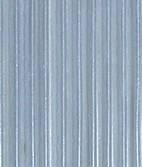



Large diaphragms and differentiated driving force. Efforts have been made to minimize unwanted diaphragm resonances by applying the driving force more evenly over a large area of the diaphragm.
Electrostatic speakers distribute the driving force over a large, flexible plastic panel suspended on a framework.
EMIT and magnetostatic speakers utillize a differentiated driving force applied to different areas of the diaphragm to compensate for the varying flexibility of its surface. However, when a flat or conical diaphragm supported at its edges is caused to vibrate only part of the diaphragm oscillates in a direction perpendicular to its surface. At the outer edges, where it is suspended, it cannot oscillate in the same manner since the surface of one side will stretch with each + sinus oscillation, while the reverse side will be compressed or "crunched" and vice versa. Thus the entire diaphragm will not move uniformely like a rigid piston, but will vibrate like a suspended flexible membrane and produce a self resonance with a pitch. (singing saw effect)
Non Uniformity of Driving force: In the Heil Air Motion Transformer. ( AMT), the driving force is applied uniformly over the entire surface of a structurally rigid diaphragm by means of the conductive aluminium foil strips.
Ability to move air efficiently: The A.V.T. ( AMT) diaphragm’s pleats propel air at a speed of 5.3 times their own velocity.Oskar Heil AVT/AMT
In order to move a large amount of air with minimum loss and provide fast response to the transients, the diaphragm must be extremely lightweight. However, if the diaphragm material is too thin and light, it will not be sufficiently rigid to prevent it from flexing and producing its own resonances. If the deformation occurs between the center area and the edges, that portion will vibrate independently of the music signal and produce standing waves or bell shaped vibrations which are clearly audible as distortion. In addition, the diaphragm will store the resonant energy and, when the music signal stops, it will continue to move in order to dissipate this energy. The continued vibration of the diaphragm will dampen (absorb) the sharp rising transients of the following music and seriously affect the quality of the music reproduction.
 single point of
energy: ( flaps)
single point of
energy: ( flaps)dual point of energy ( reduces flapping)
energy applied over the surface, (no flapping)
The unique design feature of the Heil Air Motion Transformer. which distinguishes it from all other speakers is an extremely lightweight diaphragm, folded into a number of accordeon-like pleats to which aluminium foil strips are bonded. The Diaphragm is mounted in an intense magnetic field and a music signal is applied to the aluminum strips.
This causes the pleats to alternately expand and contract in a bellows-like manner in conformance with the music signal forcing air under pressure out of the pleats and sucking the air in on the other side, the airmovement is 5 times bigger than the movement of the membrane, therefore also the velocity must be 5 time bigger.The total moving mass is approx. 1 gram, we have therefore an almost perfect transducer system. This principle can be demonstrated very simply by taking a sheet of DIN A 4 paper with a surface of 616 cm2, folding it in the center lengthwise and bending the long edges together to form an opening of 5 cm on the one side. We imagine, that the upper and lower part of the structure is closed and move each side 2.5 cm together. With a frontal surface of 140 cm2, we have now moved 770 ccm of air, compared with the 350 ccm of air moved by a flat diaphragm. Our transformation is now 1:2.2, by making the triangle (top view) a square form, we doubled the transformation to 1:4.4 The selected transformation ratio with the Heil Air Motion Transformer. is 1:5.3.
Unlike conventional speakers, whos diaphragms move air only in a direct proportion to their own movement with the inherent inertia. The A.V.T. multiplies (transforms) the Air Velocity by a factor of 5.3 (with a total mass of less than 1 gramm) and is, therefore, appropriately called an “AIR VELOCITY TRANSFORMER.”



Kithara in Cherry wood